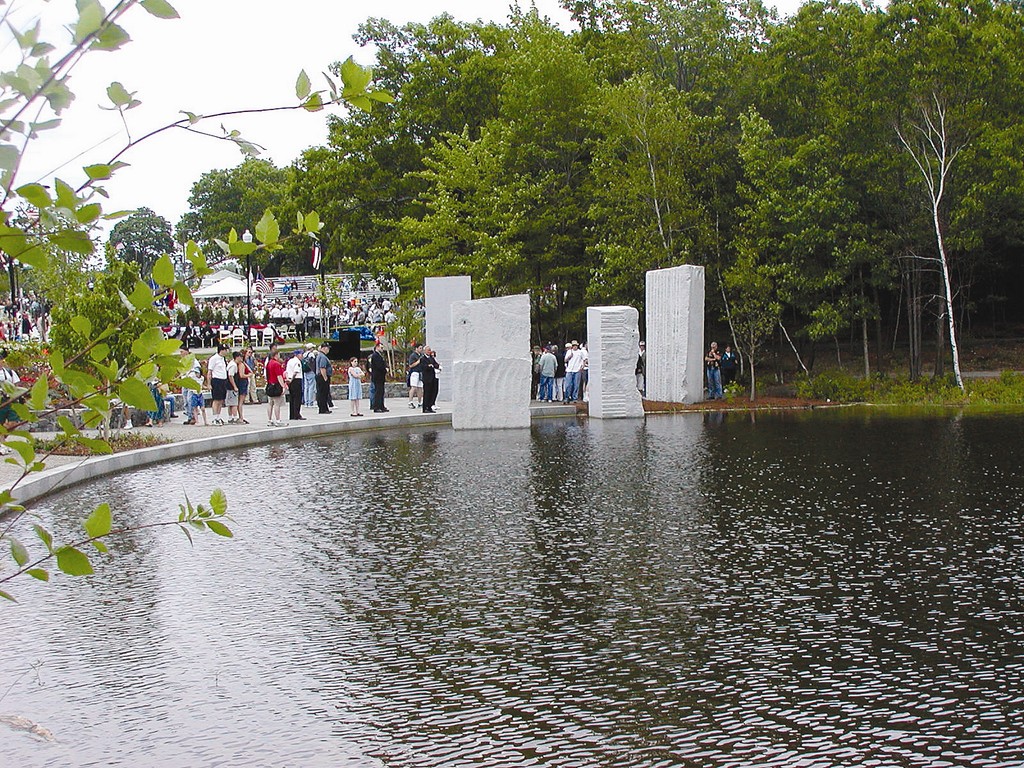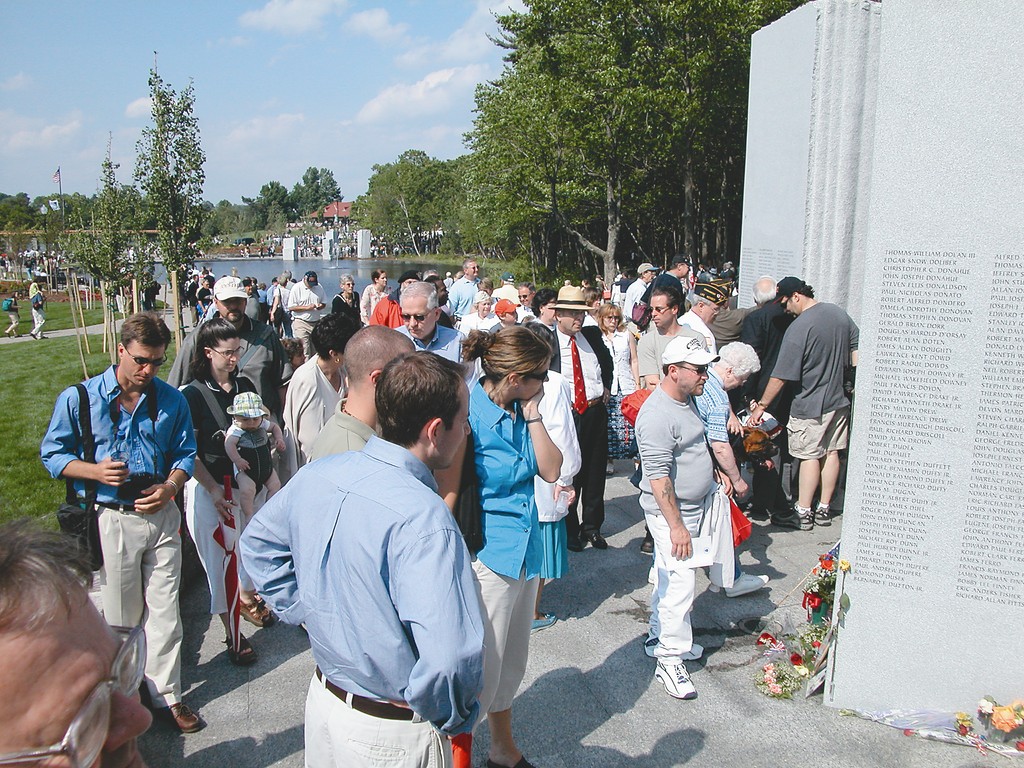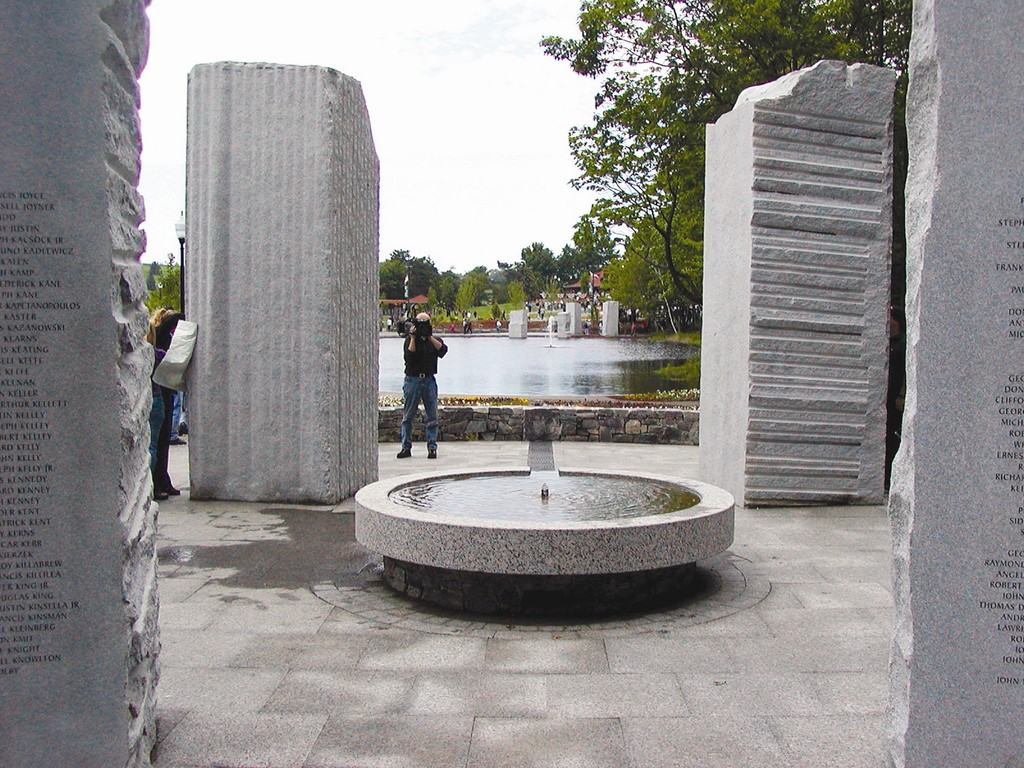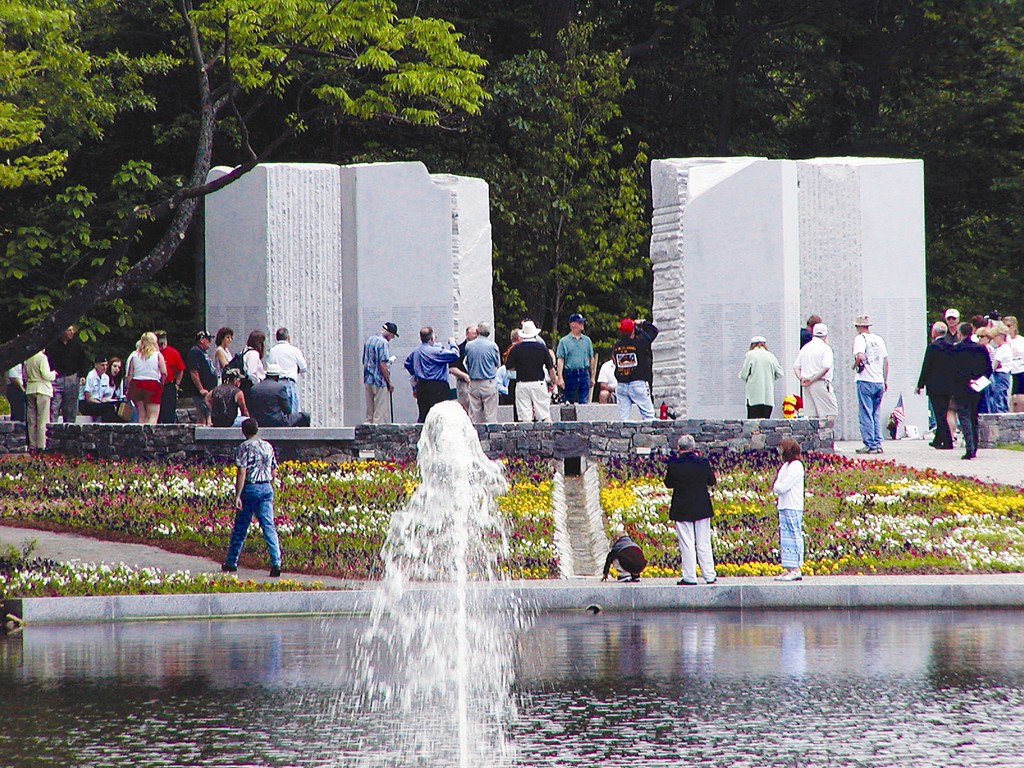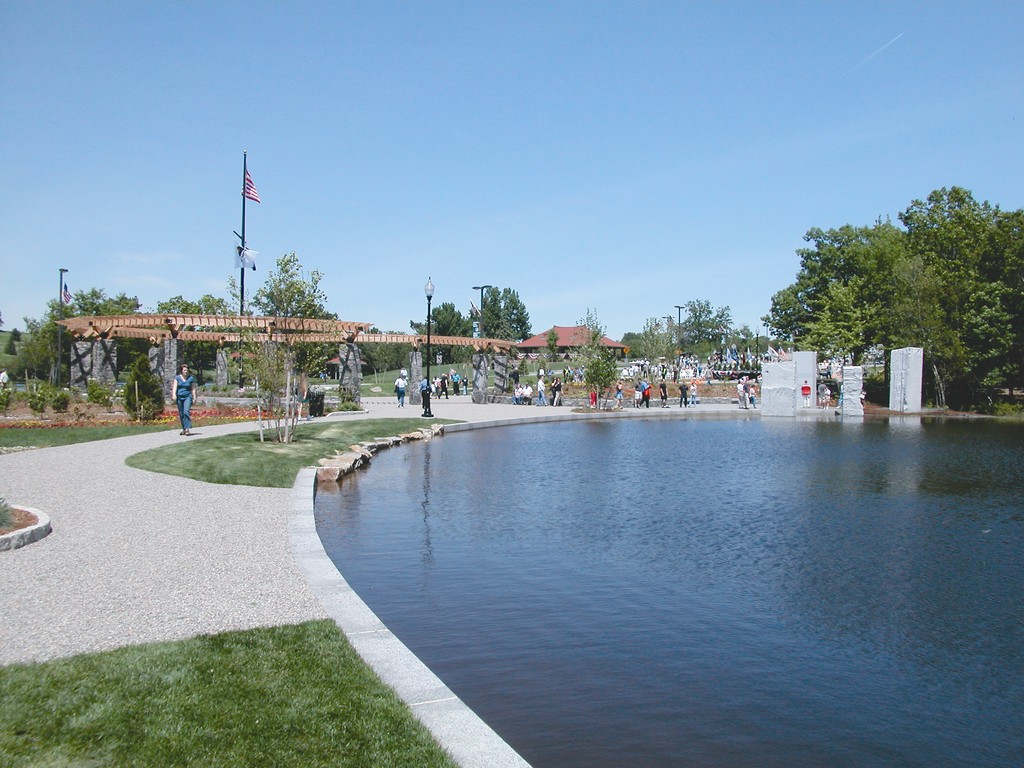
By Johannes H. Wagner, Eugene R. Bolinger
The site was chosen because the existing water, terrain and natural landscape were a perfect fit: Like no other available space, the design team saw that this setting could be used to symbolize the character of Vietnam’s landscape – wetlands and bogs, water crossings, hills and forests, meadows and plains – and shaped into a memorial to casualties of a war that ended in Southeast Asia nearly three decades ago.
It’s a beautiful and peaceful space, one that now encompasses four acres of land around the perimeter of Duck Pond, a small and scenic body of water nestled in the gently rolling landscape of Worcester’s Green Hill Park in central Massachusetts.
Some 20 years in the making, the Massachusetts Vietnam Veterans Memorial required a sustained public effort and the commitment of local citizens, business leaders and politicians alike. The process may have been difficult, but the result is a tribute of great solemnity, beauty, appropriateness and historic significance to the citizens of the Commonwealth.
Our firm, Weston & Sampson Engineering, was called on to provide the landscape design and to oversee construction – and has been honored to be involved from the project’s inception in the early 1980s. As was true of so many others who became involved in the long process, we were thrilled to see the vision for this memorial finally come to fruition.
THE PROGRAM
As conceived, the memorial includes three important spaces: “Place of Flags,” “Place of Words” and “Place of Names,” all situated at or near the shore of Duck Pond.
Visitors enter the memorial site through Place of Flags, a fieldstone-and-wood arbor planted with climbing hydrangea. From this vantage point, they look across Duck Pond to see the massive granite monoliths at Place of Names in the distance.
Just a few paces east of the gateway, visitors enter Place of Words to view a set of four granite monoliths that stand on land and in the water and have been engraved with excerpts of letters written to loved ones by soldiers who fell during their tours of duty in Vietnam.
| Place of Flags(see also the article’s opening image, above) |
The monoliths are situated on both land and in water to symbolize movement through the landscape and everyday conditions in Vietnam. Each letter presents an account of life during the war and expressions of thanks and love – a moving tribute that draws the visitor to the water’s edge to make key connections between the memorial’s purpose and the tranquil surrounding environment.
From here, visitors may either follow an unpaved woodland path and boardwalk that crosses over a wetland area or follow a more formalized and manicured path that meanders along the western edge of the pond to Place of Names. Here, a group of six granite monoliths commemorate 1,537 individuals from the Commonwealth of Massachusetts who lost their lives during the war. The subtle sound of a gently splashing fountain and spillway add to the serenity of the space, allowing reflection on the meaning and enormity of the losses represented by the memorial itself. From this meditative space, visitors can see Place of Flags and Place of Words across the pond.
Leaving Place of Names, visitors pass through wildflower meadows – reflecting a spirit of life and regeneration – before returning eventually to Place of Flags and the memorial’s gateway.
The paths, Places and grounds of the Memorial feature granite and brick pavements, stone walls, irrigation systems, lighting, signage, extensive gardens and plantings as well as the meditative seating areas linked by the meandering pathways, but the engraved granite monoliths along the water’s edge are definitely the focal points of the memorial, with the water itself serving as a significant foil.
Water has so much significance because, as any veteran will attest, it was such a prominent part of the Vietnam experience – not just associations from being transported over oceans to get “in-country,” but also because of the prominence of bodies of water, rivers and wetlands in the Southeast Asian landscape. The reflection of the monoliths on the surface of Duck Pond recalls, enhances and elevates the experience.
A LONG HISTORY
As was suggested at the outset, however, this serene conclusion was long in the making.
Initially envisioned by a group of veterans’ organizations during the early 1980s and discussed as something that would be appropriate at one of several potential sites in Boston itself, the memorial was long delayed due to inadequate funding and the lack of a clearly articulated vision or design.
By the mid-1980s, the Vietnam Veterans Memorial Trust had been formed, and its members approached legislators about setting up a memorial in central Massachusetts to make it more readily accessible to visitors from around the state. With legislative encouragement, the trust approached the City of Worcester with a request for assistance in finding a site. Reviewing ten suggestions, the trust settled on Duck Pond in Green Hill Park as their primary recommendation.
In 1988, the city offered the site and agreed to co-sponsor a design competition with a modest level of private and public funding. Ten designs were selected as finalists, and a concept from the artist team of Harby/Rogers/Catanzaro was chosen. A model was presented to the Governor’s Council for approval and for formal acceptance by the legislature as the official design and site for the statewide memorial.
| Place of Words |
On parallel tracks, preliminary construction documents were drawn up and local, state and federal permitting efforts for the establishment of the memorial were undertaken. With changing economic conditions, however, the project was delayed once again – and stayed on the shelf for more than ten years when, in 1999, the legislature finally appropriated funds to build the memorial.
The success of the memorial ultimately depended on a collaboration of state, municipal and private entities as we honed in on obtaining final environmental permits, developed the final design and construction documents and managed all phases of construction. The widely heralded outcome of the project was a direct result of the highly constructive and cooperative atmosphere that allowed so many individuals and groups to work together to achieve a most significant goal.
KEY ALIGNMENTS
For its part, the state provided the primary funding, while the City of Worcester ceded a dramatic space at the heart of its 500-acre flagship, Green Hill Park. But funding and a home were, as we soon discovered, just two among the large number of factors that had to be aligned to move the project along.
The issue of public access and convenience was one such consideration. Duck Pond is easily accessible and located within a well-known park with its own history of use by local citizens and others, but the Massachusetts Highway Department is charged with improving access to state memorials and historically significant sites and saw that park access needed some upgrading.
Before they were finished, the department provided full-depth roadway reconstruction and major utility installations to enhance access to what they considered to be a “remotely situated” memorial. They also set up directional signage and site information along the many state highways that pass through and around Worcester and its suburbs.
The Massachusetts Executive Office of Environmental Affairs, the Worcester Conservation Commission and the U.S. Army Corps of Engineers also became involved because part of the construction program called for draining Duck Pond and dredging away sediments that had been found to contain elevated levels of total petroleum hydrocarbons.
The disturbance of the wetlands area was to be temporary, but the permits specifically required the eventual restoration of wetlands all around the pond’s perimeter. Our plans approved, the city’s Parks Department drew down the pond, after which the Massachusetts National Guard completed the dredging and removal of pond sediments.
| Place of Names |
Worcester’s Parks Commissioner Michael V. O’Brien, along with Massachusetts Veterans Affairs Commissioner and Medal of Honor recipient Thomas G. Kelley, made dramatic presentations to catalyze public support for the project and raise hundreds of thousands of dollars in additional funding and labor and material donations from private entities.
Indeed, corporate sponsorships were crucial to completing the project without resorting to scarce additional public funding. In this effort, the Veterans Agent for the City of Worcester, Pierce Gould, worked tirelessly to involve veterans and veterans groups throughout Massachusetts in the project as it headed toward dedication ceremonies.
A TIME FOR REMEMBRANCE
The memorial was dedicated in weekend-long ceremonies in June 2002, where we joined 5,000 individuals, representatives of veterans’ groups and a host of federal, state and municipal officials to pay tribute and respect to Massachusetts’ veterans of the Vietnam War.
The ceremonies began with an ecumenical service followed by formal recitation of the 1,537 names of military personnel from Massachusetts who lost their lives during the war.
Massachusetts Senator John F. Kerry, a navy veteran of the Vietnam War, was keynote speaker and captured both the emotion of past losses and the importance of having a living, permanent memorial to be shared by all those from Massachusetts whose lives were changed by the Vietnam conflict. Senator Kerry also expressed his admiration for the Massachusetts Memorial, comparing its emotional impact with that of the national memorial in Washington, D.C.
Now, so many years later, the courageous actions of 1,537 servicemen and -women have been respectfully acknowledged for all time, along with the families of those who lost their lives as well as the veterans who came home to a country ambivalent toward the plight of veterans and their families.
It is our hope, and the hope of everyone who participated in the development of the memorial through the past 20 years, that some measure of peace, comfort and unity can be found within this beautiful setting in the heart of Green Hill Park.
Johannes H. Wagner & Eugene R. Bolinger are associates at Weston & Sampson Engineers, Inc., a 103-year old environmental and infrastructure-engineering consultancy based in Peabody, Mass. A registered landscape architect and decorated Vietnam War veteran, Wagner has more than 35 years’ experience in landscape, architectural and environmental design. Bolinger is a registered landscape architect with nearly 20 years’ experience in managing landscape design projects throughout New England.













